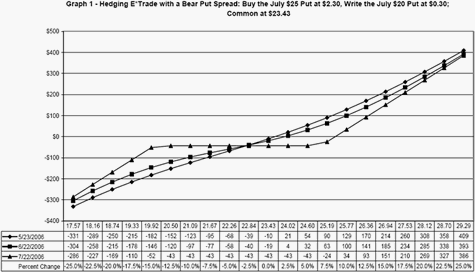Hedging with Bear Spreads
Post on: 16 Апрель, 2015 No Comment

In our May 22, 2006 report, we showed you how you can hedge your stock with “collars,” which are basically combinations of covered calls and protective puts. This week, we show how you can hedge with a bear spread. This particular hedge is attractive in times such as these when the demand for nominally cheap insurance is driving up the price of the lower strike puts.
The Basic Bear Spread
A basic bear spread consists of buying a higher strike option (call or put — but not calls and puts in the same spread) and selling another call or put with the same expiration but with a lower strike price. Such a spread constructed with puts is called a bear put spread, while one constructed with calls is named a bear call spread. When you create a bear put spread, you pay a net debit of premium since you are buying the (higher strike) higher premium put and selling the (lower strike) lower premium put. When you create a bear call spread, you receive a net credit of premium because you are selling the (lower strike) higher premium call and buying the (higher strike) lower premium call. See “Option Spreads I: Basic Bull and Bear Spreads, Ot051017.Pdf in our Options Reports Archive.
Tailoring Your Insurance
As we often stress, options are insurance. When you hedge with a bear spread, you are buying insurance the option purchased and selling insurance with the option sold. In effect, you are capping off your coverage beyond a certain level of possible losses in the stock. (Similar caps in coverage exist in many home, health and auto insurance policies.)
Does it make sense to cap your insurance? Often it does, provided you believe that, over the life of your hedge, the risk is limited. For instance, if the stock is trading at $20 and you have reason to believe that that the stock might decline to $15 but no lower, then it makes a lot more sense to buy a $20 put and then sell one with a strike price of $15 then it does to buy a put with a strike price of $15. If you had bought the $15 put and the stock had fallen to that level, then you would reap no insurance benefit. All too often, investors make the mistake of buying nominally cheap insurance that will never really protect them. It is much more effective to insure your risk in accordance with your reasonable expectations of what the risks might be.
Current Bear Spread Opportunities
The recent sharp decline in the stock market (S&P 500 down more than 5% over the past three weeks) has caused a sharp upward spike in many premiums, because of demand for put protection, especially in the lower strike prices. At the same time many at-the-money or higher strike options have remained reasonably priced. This has created a plethora of favorably priced bear spreads. For instance, our template found more than 15,000 favorably priced bear puts spreads and a like number of bear call spreads from our daily download files Puts.Csv and Calls.Csv.
A Bear Put Spread Hedge Example
In Graph 1 below, we show an example of a stock, E*Trade, hedged with a bear put spread with the stock at $23.43. In this example, we have bought the July $25 put for $2.30 and written the July $20 put at $0.30. From this transaction, there was a net debit of $2.00 per share versus a “fair value” (the net of our estimated prices) of $2.43 per share. Therefore, the spread was favorably priced. One attractive feature of this bear spread hedge is that even though it offers significant downside protection, it also allows the investor to enjoy much of the upside if the stock were to rise right away.
A Bear Call Spread Example
In Graph 2 below, we show the S&P 500 ETF (SPY) hedged with a bear call spread. In this example, with the SPY at $126.30, we have written the in-the-money August $115 call at $12.80 and, to give us some upside, we have also bought the August $135 call at $0.60. This spread gave us a net credit premium of $12.20, which is a wider credit than our model’s net estimates of $10.63. Thus, this spread was also favorably priced. Notice in the graph that as long as the SPY ends up above $115, the investor will have made an $88 profit at the August expiration. The investor also gets to reap pretty decent gains if the Index were to start rising right away.














